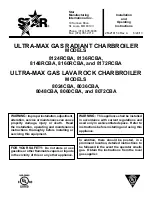
© MHG Heating Ltd
23
MHG Heating Ltd, Unit 4 Epsom Downs Metro Centre, Waterfield, Tadworth, Surrey, KT20 5LR
0845 6448802 Telephone. 0845 6448803 Fax. Email
Website www.mhgheating.co.uk
010908
9.0 Filling The System
The Initial filling of a sealed heating system, and subsequent refilling, must be by a method that has
been approved by the Water Regulation Advisory Scheme (WRAS) for that type of heating system.
i.e. Domestic
(
In-House)
Fluid
Category
3
(
C-3)
Non Domestic (Other than
In-House)
Fluid Category 4 (
C-4)
For Category 3 systems, the approved method of filling must comprise of the following components in
the arrangement shown;
•
Control Valve incorporating a Double
Check Valve on the Mains Cold Water
pipework.
•
Temporary Connecting Hose, which must
be disconnected after use.
•
Control Valve, on the heating system.
For Category 4 systems, the approved method of filling must comprise of the following components in
the arrangement shown;
•
Control Valve.
•
Strainer.
•
Verifiable Backflow Device with Reduced
Pressure Zone (RPZ Valve)
•
Incorporating a ‘Type BA’ Air Gap.
•
Tundish.
•
Control Valve.
Further more, in accordance with BS 6644: 2005 system with an input greater than 70kW (nett), an
automatic water replenishment unit shall be installed to automatically replenish any lost or
evaporated water.
Please refer to BS 6644: 2005 for allowable water replenishment methods for use with
sealed/pressurized heating systems.
For information on a comprehensive range of pressurization units that comply with current British
Standards and WRAS Regulations, please contact MHG Heating Ltd Sales.
9.1 Expansion Vessel
In accordance with BS 6644: 2005, WRAS Regulations, and Local Authority Water Regulations, as
applicable, the installer shall install a suitably sized, and approved, Expansion Vessel to ensure that the
water capacity of the system has ample expansion capacity.
The location of the expansion vessel shall only be isolatable from the system via a Lockable Type
Service Valve, which shall be locked in the
OPEN position, to prevent accidental isolation.
Furthermore, a drain facility should be provided adjacent to the expansion vessel to aide the routine
maintenance, overhaul, of the vessels Air Pressure setting.
















































